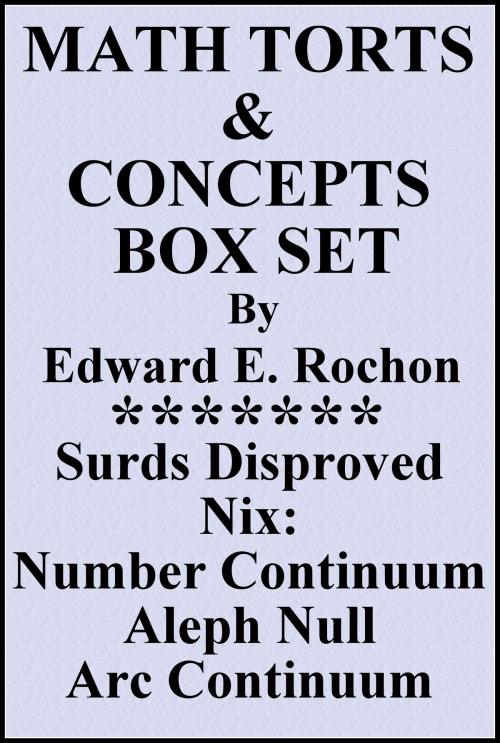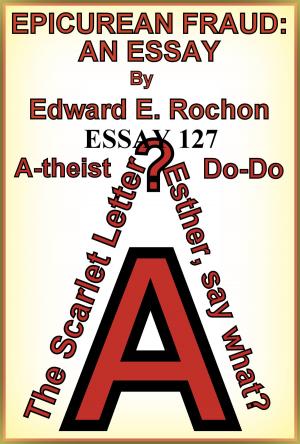Math Torts & Concepts Box Set
Nonfiction, Science & Nature, Mathematics, Religion & Spirituality, Philosophy| Author: | Edward E. Rochon | ISBN: | 9781370446346 |
| Publisher: | Edward E. Rochon | Publication: | May 13, 2018 |
| Imprint: | Smashwords Edition | Language: | English |
| Author: | Edward E. Rochon |
| ISBN: | 9781370446346 |
| Publisher: | Edward E. Rochon |
| Publication: | May 13, 2018 |
| Imprint: | Smashwords Edition |
| Language: | English |
This box set spans six years of essays on math commentary. It includes whole essays (quite short), abstracts from longer essays, and abstracts from my book: Paradoxes. My most important accomplishment on this subject is the demolishing of the 2,500 year long reign of irrational numbers. The basic refutation is so simple that it calls into question the rationality of mathematicians whose large store of specialized training and knowledge, group connections and discussion forums, make this a millennial scandal. More so, that a man of little detailed knowledge should explode this fallacy. How could men such as Descartes, Newton, Leibniz, Euclid, Archimedes not see the obvious error, be fooled by the deceptive algebraic argument of Hippasus and Euclid's further obfuscation of the matter? For my part, fooled by the subtleties of the algebraic proofs, intimidated by the centuries of acceptance, over complicated my refutations and stumbled on that complexity. Without even leaving the foreword, we put the matter in its simplest form.
The ratio of the unit square sides (s) to the diagonal is: √2/1. We try to find the commensurable value that fits into both numerator and denominator. First, √2/1 = √2. We see that (s) is within the root and do not need the denominator (s). We note that all fractions are portions of the unit value (1). We note that all number bases are commensurable in fractional parts to (1). The first power of 10 is commensurable by ten (1/10th)'s. The (1/100th) is commensurable into the 10th's positions, etc., for all reciprocal powers of the mantissa or fractional positions. This is absolutely certain by the definition of base positional notation. That being the case, how could not all elements of the mantissa not be commensurable to each other and the unit whole number to the left of the decimal point? They are. and (1) = (s) and the proof is done. If you suppose some trick of positional notation, we know that all fractions are ratios of whole numbers, and that all whole number integers are commensurable by (1) = (s). There must be a least common denominator, however complex or obtuse to find, and that avenue of refutation is a logical dead end by definition of whole numbers (all additives of the unit value.)
That's it, done. The 2,500 year nightmare and swindle is over. We will repeat this in the body of the box set from different approaches. You will find repetition of basic concepts here. If that bothers you, just scan or gloss over them in mental notation. Basic concepts are simple on the face of it but not so simple upon reflection, as philosophers know all too well. Time, space, motion? Of course I know what these are. Yet, studying the subtleties of these matters, leaves us frustrated. People come up with paradoxes that seem to cloud the issues. What to put first in the set is a puzzle. How should I proceed? I start with my most significant simple proof and leave supporting matters for later. Abstracts from largely theological and philosophical essays appear here....
Essays Included:
PARADOXES (Abstracts)
CONTRA PANTHEISM (ATHEISM): AN ESSAY (Math concepts)
CONTRA NOMINALISM: AN ESSAY (Metaphysical concepts)
CUBICS: A NUMBERS ESSAY (All is arc, no parallel lines critique)
GOD & SQUARE ROOTS (Critique of surds)
GOD & SQUARE ROOTS II (Critique of surds)
AXIOMS & THEOREMS: AN ESSAY (Identity, related matters)
NUMBER BASES & DIGITS: AN ESSAY (Big number bases and advantages)
POLYGON CALCULUS (Flaws in limits, infinitesimals, asymptotes. Etc.)
This box set spans six years of essays on math commentary. It includes whole essays (quite short), abstracts from longer essays, and abstracts from my book: Paradoxes. My most important accomplishment on this subject is the demolishing of the 2,500 year long reign of irrational numbers. The basic refutation is so simple that it calls into question the rationality of mathematicians whose large store of specialized training and knowledge, group connections and discussion forums, make this a millennial scandal. More so, that a man of little detailed knowledge should explode this fallacy. How could men such as Descartes, Newton, Leibniz, Euclid, Archimedes not see the obvious error, be fooled by the deceptive algebraic argument of Hippasus and Euclid's further obfuscation of the matter? For my part, fooled by the subtleties of the algebraic proofs, intimidated by the centuries of acceptance, over complicated my refutations and stumbled on that complexity. Without even leaving the foreword, we put the matter in its simplest form.
The ratio of the unit square sides (s) to the diagonal is: √2/1. We try to find the commensurable value that fits into both numerator and denominator. First, √2/1 = √2. We see that (s) is within the root and do not need the denominator (s). We note that all fractions are portions of the unit value (1). We note that all number bases are commensurable in fractional parts to (1). The first power of 10 is commensurable by ten (1/10th)'s. The (1/100th) is commensurable into the 10th's positions, etc., for all reciprocal powers of the mantissa or fractional positions. This is absolutely certain by the definition of base positional notation. That being the case, how could not all elements of the mantissa not be commensurable to each other and the unit whole number to the left of the decimal point? They are. and (1) = (s) and the proof is done. If you suppose some trick of positional notation, we know that all fractions are ratios of whole numbers, and that all whole number integers are commensurable by (1) = (s). There must be a least common denominator, however complex or obtuse to find, and that avenue of refutation is a logical dead end by definition of whole numbers (all additives of the unit value.)
That's it, done. The 2,500 year nightmare and swindle is over. We will repeat this in the body of the box set from different approaches. You will find repetition of basic concepts here. If that bothers you, just scan or gloss over them in mental notation. Basic concepts are simple on the face of it but not so simple upon reflection, as philosophers know all too well. Time, space, motion? Of course I know what these are. Yet, studying the subtleties of these matters, leaves us frustrated. People come up with paradoxes that seem to cloud the issues. What to put first in the set is a puzzle. How should I proceed? I start with my most significant simple proof and leave supporting matters for later. Abstracts from largely theological and philosophical essays appear here....
Essays Included:
PARADOXES (Abstracts)
CONTRA PANTHEISM (ATHEISM): AN ESSAY (Math concepts)
CONTRA NOMINALISM: AN ESSAY (Metaphysical concepts)
CUBICS: A NUMBERS ESSAY (All is arc, no parallel lines critique)
GOD & SQUARE ROOTS (Critique of surds)
GOD & SQUARE ROOTS II (Critique of surds)
AXIOMS & THEOREMS: AN ESSAY (Identity, related matters)
NUMBER BASES & DIGITS: AN ESSAY (Big number bases and advantages)
POLYGON CALCULUS (Flaws in limits, infinitesimals, asymptotes. Etc.)















